ioSafe SoloPRO: Disaster Proofing Your Storage Needs
by Ganesh T S on April 9, 2012 6:00 PM EST- Posted in
- Storage
- IT Computing
- ioSafe
ioSafe holds a number of patents related to disaster proofing of digital storage media. ioSafe's CEO Robb Moore is the primary inventor of most of those patents. In this section, we will take a brief look at the various patents related to the ioSafe SoloPRO. Note that the SoloPRO might not be using all of the inventions mentioned in the patents below.
Fire Resistant, Forced Air Cooled Enclosure for Computer Digital Data Storage Device (US Patent No. US 7,211,742 B2):
This patent provides details of how ioSafe is able to design a fireproof enclosure despite the presence of a fan to cool the operating contents. Even though a single hard disk drive used as a backup target (such as in the SoloPRO) might not require active cooling, it is definitely a necessity in multi-disk configurations.
The invention presents a fireproof enclosure with an inlet for air to flow through (aided by a fan) and cool the storage device inside. However, this inlet could prove detrimental in case of a fire (where the exposure of the internal storage device to high temperatures / fire through the inlet could cause its destruction).
To solve this problem, the opening is protected by a fire resistant movable hatch. This movable hatch automatically closes upon reaching a predetermined temperature (which is something not reached by the drives during operation, and also below something which can actually damage the drives). The closing mechanism could use any temperature sensitive element (eutectic metal / plastic / rubber / wax etc.) coupled with either actuation springs that expand or contract to close the hatch or just rely on gravity to bring the hatch down (if the temperature sensitive element is actually supporting the top of the enclosure). An alternative to a mechanical closing system is an electronic solenoid based system where the actuator is a thermocouple.
Example of springs being used as actuators to close hatch held in place by a temperature sensitive element (Diagrams from Patent No. US 7,211,742 B2). Note that this is not the actual mechanism used in the SoloPRO.
In each of the above methods, a temperature sensitive element is activated when a threshold temperature is reached, which protects the internal data storage device from the high external temperature.
Fire Resistant and/or Water Resistant Enclosure for Operable Computer Digital Data Storage Device (US Patent No. US 2009/0050365 A1):
This patent details inventions which provide for hatchless enclosures (with or without fans), water resistant and non-actively cooled enclosures (with or without hatches), and enclosures with meltable materials which can close off ventilation passageways in the case of a fire.
The movable hatches described in the previous patent tend to increase the cost of the device. In this patent, ioSafe describes how a 1.5 inch thick gypsum wall with small sized vents could support fan-based cooling while also protecting the internal contents from the high temperatures outside. In the presence of a fire, the air inside expands and gets forced out through the vents. This outward air flow counteracts the flow of external heat through the vents. The vents are designed to be maze-like to reduce the amount of external heat which can get inside. Of course, the inner chamber and the vents have to be appropriately sized to provide fire resistance and prevent data loss.
Labyrinthine vents to allow for expanding internal air volume to counter the external heat (Diagram from Patent No. US 2009/0050365 A1)
The SoloPRO is also water resistant, and this patent also describes the water resistant and heat conducting covering for the data storage device. In addition, the patent also presents how intumescent or meltable materials can be used to seal off the inlets for the power and data cables of the data storage device.
Water resistant pouch with an embedded finned heat sink to cover the storage media. Note that the SoloPRO's water resistant pouch doesn't have a finned heat sink (Diagram from Patent No. US 2009/0050365 A1)
The water resistant pouch is made of heat conducting material so that the heat produced by the drive is taken away. It could be either a metallic foil or a more rigid enclosure. The enclosure could also internally contain fins for better thermal performance. The metallic pouch is provided with an elastomeric coating. A gasket around the perimeter of the pouch provides a water resistant enclosure.
Fire Resistant and Water Resistant Enclosure for Operable Computer Digital Data Storage Device (US Patent No. US 7,843,689 B2):
This patent is the one on which a majority of the features of the SoloPRO are based. It improves upon the inventions detailed in the previous two patents by:
- Super-saturating the enclosure (made of gypsum or concrete) with water, and preventing its evaporation with vapor barriers on both the internal and external walls of the enclosure (during a fire, this barrier melts and the water in the walls absorb the latent heat of vaporization, allowing the extension of the time over which the internal storage device is protected from damage).
- Not allowing the movable hatch design to completely close off the internal unit, but allow a slight opening for superheated steam to escape (can be used for high power devices - 20 to 2000 W)
- Providing ventilation passageways for expanding air and steam inside the unit in case of a fire (in hatchless designs)
State of the enclosure prior to fire exposure. Note the size of the vents near 91 and 92 which allow for flowing air to cool the storage media during normal operation (Diagram from Patent No. US 7,843,689 B2)
State of the enclosure after fire damage. Note that the size of the vents near 91 and 92 have decreased, but they still allow steam built up internally to escape outside (Diagram from Patent No. US 7,843,689 B2)
The water resistant pouch used in this invention is similar to the one in the previously described patent.


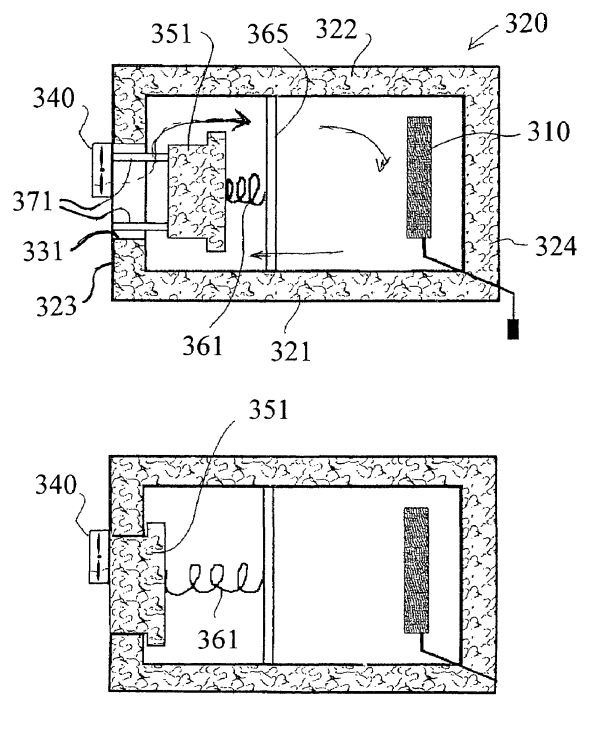
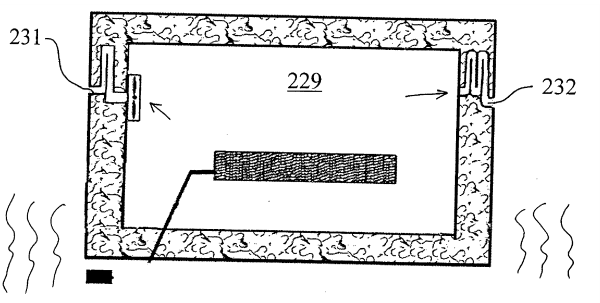
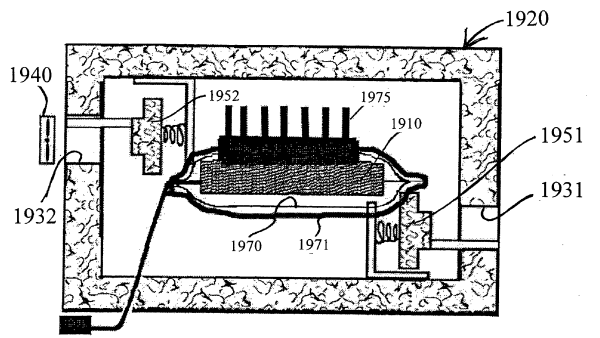
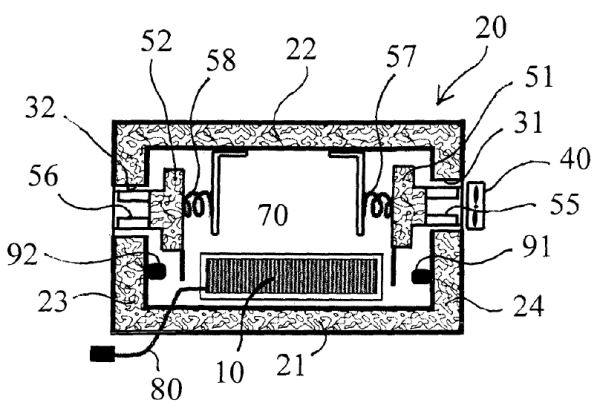
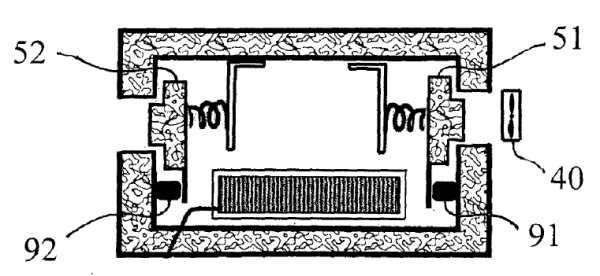








34 Comments
View All Comments
Coup27 - Monday, April 16, 2012 - link
Hi Rob,It's nice to have a CEO, or even a company rep in these comments. I don't know if you are still checking these comments but if you are, is there a reason why there is no NAS version of this product? USB obviously has cable length limitations and if you wanted to secure the ioSafe somewhere on-site out of the practical reach of theft, the chances are it's going to be more than 5M away from my expensive server.
My company is only small, about 30 staff with 10 computer based users. Today I have spent longer "discussing" the my options for backing up my IT provider than I did talking about the actual server implementation and roll out. Every option we discussed had a pit fall and we were left with the classic and incredibly frustrating "2 x external drive shuffle alternating once a day/week by a member of staff who someone then takes home" [insert expletive here]
As has been mentioned already, cloud backup completely fails when backing up considerable data, especially large email repositories.
Regards
robb.moore - Monday, April 16, 2012 - link
Hi Coup27-At ioSafe we use a Synology NAS (RAID, NAS, Private Cloud, Etc) with an ioSafe SoloPRO as the backup target for the NAS using the eSATA port on the back of the NAS. This will allow you to place the ioSafe anywhere on the network (wired or wireless).
This works really well imo for the small business as there's no backup software to install on the clients if you're just after protecting the NAS. If you'd like to image the entire OS for the attached clients, you can either buy an ioSafe for each computer user and image it that way - reducing the data pushed across the LAN (this is what we do at ioSafe). Or you can image the user's hard drives across the LAN to the NAS which in turn backs up to the ioSafe (this is what I do for my home computers).
Additionally, you can layer in whatever offsite strategy you'd like if you feel you need it at this point.
We're also working on some other NAS solutions that we'll be announcing later this year. Hope that helps.
Robb Moore
CEO
ioSafe
Coup27 - Thursday, April 19, 2012 - link
Hi Robb,Unfortunately having to rely on a seperate NAS to add network capabilities adds a significant cost to a quite reasonably priced item.
When I can eventually afford my own house I would certainly consider a NAS ioSafe to place in my loft as a secure backup. This would be inpractical to be taken during a theft, and would survive water and fire damage. Obviously that would not include an off-site backup but I'm not sure how practical that is for a domestic user with TB's of data. I think a NAS ioSafe would be an excellent overrall solution and hope so see them soon!
Cheers
glugglug - Monday, March 4, 2013 - link
Can the ioSafe be opened up and the drive inside it replaced with a larger one?Will opening it break some seals required for the disaster proofing?